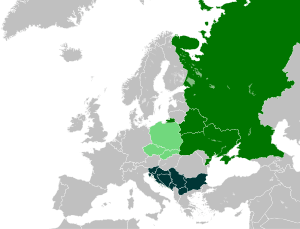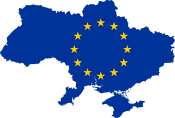Don Cossacks
|
Flag of the Don Cossacks. | |
| Total population | |
|---|---|
| (0.2–2 million) | |
| Regions with significant populations | |
| 1,500,000 in 1918; 140,000 in 2010[1] | |
| Languages | |
| Dialect of Russian: Don Balachka, Don Gutar | |
| Religion | |
| Eastern Orthodox Christians, Starovers | |
| Related ethnic groups | |
| Russians,[2] Kalmyks, Brodnici, Circassians, Ukrainians | |
| Part of a series on |
| Cossacks |
|---|
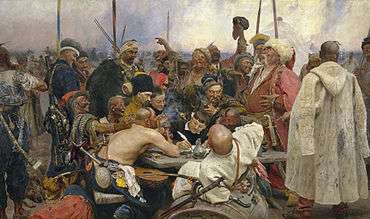 |
| Cossack hosts |
| Other groups |
| History |
| Cossacks |
| Cossack terms |
Don Cossacks (Russian: Донские казаки) are Cossacks who settled along the middle and lower Don. Historically, they have been located within what was the Don Cossack Host (Russian: Всевеликое Войско Донское, Vsevelikoye Voysko Donskoye), which was either an independent or an autonomous democratic republic in the present day Southern Russia and the Donbas region of Ukraine, from the end of the 16th century until 1918. As of 1992, by the presidential decree of the Russian Federation, Cossacks can be enrolled on a special register. A number of Cossack communities have been reconstituted to further the Cossack cultural traditions, including those of the Don Cossack Host.
Don Cossacks have had a rich military tradition, playing an important part in the historical development of the Russian Empire and participating in most of its major wars.
Etymology and origins
The name Cossack (казак, козак) was widely used to describe "free people" as opposed to others with different standing in a feudal society (i.e., peasants, nobles, clergy, etc.). The word 'cossack' was also applied to migrants, free-booters and bandits.[3]
The exact origins of Cossacks are unknown. In modern view, Don Cossacks are descendants of Slavic people, who came from the Dnieper, Novgorod Republic, and Principality of Ryazan, and of Goths-Alans[4] people originating from the Western part of North Caucasus.
History
Early history
More than two thousand years ago the Scythians lived on the banks of the river Don. Many Scythian tombs have been found in this area.[5] Subsequently the area was inhabited by the Khazars and the Polovtsians. The steppes of the Don River were called "The Wild Field" (Дикое Поле). The area was under the general control of the Golden Horde, and numerous Tatar armed groups roamed there, attacking Russian and foreign merchants.
The first Christians to settle on the territories around the Don were the Jassi and Kosogi tribes.[6] After the fall of the Golden Horde in 1480, more Russian[7] colonists started to expand onto this land from the Novgorod Republic[8] after the Battle of Shelon and from neighboring Principality of Ryazan.[9] Until the end of the 16th century, the Don Cossacks inhabited independent free territories.[10]
15th–17th centuries
Cossacks of Ryazan are mentioned in 1444 as a defenders of Pereslavl-Zalessky against the units of Golden Horde and in a letter of Ivan III of Russia since 1502. After the Golden Horde fell in 1480, the area around the Don River was divided between the Crimean west side and the Nogai east side. On their border since the 14th century the vast steppe of the Don region was populated by those people who were not satisfied with the existing social order, by those who did not recognize the power of the land-owners, by runaway serfs, by those who longed for freedom. In the course of time they turned into a united community and were called "the Cossacks". At first the main occupation of these small armed detachments was hunting and fishing—as well as the constant struggle against the Turks and the Tatars who attacked them. Only later they began to settle and work on the land.
16th century
The first records relating to the Cossack villages: the "stanitsa", date back to 1549. In the year 1552 Don Cossacks under the command of Ataman Susar Fedov joined the Army of Ivan the Terrible during the Siege of Kazan in 1552. On 2 June 1556 the Cossack regiment of Ataman Lyapun Filimonov, together with the Army of Moscovits comprising strelets, conquered and annexed the Astrakhan Khanate.
During the reign of Ivan the Terrible (Ivan IV), the ataman Yermak Timofeyevich went on an expedition to conquer Siberia. After defeating Khan Kuchum in the fall of 1582 and occupying Isker: the capital of the Siberian Khanate, Yermak sent a force of cossacks down the Irtysh in the winter of 1583. The detachment led by Bogdan Bryazga (according to other sources, the Cossack chieftain Nikita Pan); passed through the lands of the Konda-Pelym Voguls and reached the walls of the town of Samarovo. Taken by surprise by the cossack attack, the Ostyaks surrendered. In fall 1585, shortly after Yermak's death, Cossacks led by voevoda (army commander) Ivan Mansurov founded the first Russian fortified town in Siberia, Obskoy, at the mouth of the Irtysh river on the right bank of the Ob river. The Mansi and Khanty lands thus became part of the Russian state, finally secured by the founding of the cities of Pelym and Berezov in 1592 and Surgut in 1594. As a result of Yermak's expedition, Russia was able to annex Siberia.
17th century
During the Polish–Muscovite War (1605–18), the Polish–Lithuanian noble Aleksander Józef Lisowski founded a cavalry mercenary group (named Lisowczycy after his death) from various outlaws, partly Don Cossacks. This group served under the Polish Crown; after the war with Muscovites Lisowczycy took part in the Moldavian Magnate Wars (Battle of Humenné in November 23, 1619) at Upper Hungary, (now eastern Slovakia), later they plundered Silesia and Moravia as allies of Habsburg armies in the Bohemian Revolt – first phase of Thirty Years' War. This phase culminated in the Battle of White Mountain in November 8, 1620 (near Prague, the capital of the Crown of Bohemia, now the Czech Republic), where the Lisowczycy were sent by Johann Tserclaes, Count of Tilly against Hungarian cavalry. They were victorious, capturing twenty standards. After the battle, they terrorised village people around Prague and other cities,[11] so they were expeditiously paid and released from service in May 7, 1621. Some returned to Poland, others served under Habsburg Maximilian I, Elector of Bavaria.
Under Peter the Great and subsequent rulers, the Don Cossacks participated in numerous military campaigns, which resulted in the expansion of the Russian Empire from the Black Sea to the Baltic Sea. For years, the Cossacks waged war against the Ottomans and the Crimean Khanate. The Siege of Azov in 1641 was one of the key actions in Don Cossack history. After total taking of the Free Territories of Don Cossacks under the Moscovits control, Don Cossack history is totally intertwined with the history of the rest of Russia. In exchange for protection of the Southern borders of medieval Russia, the Don Cossacks were given the privilege of not paying taxes and the tsar's authority in Cossack lands was not as absolute as in other parts of Russia.
During this period, three of Russia's most notorious rebels, Stenka Razin, Kondraty Bulavin and Emelian Pugachev, were Don Cossacks.
18th–19th centuries
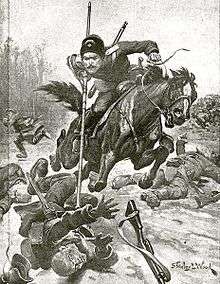
After 1786, the territory of the Don Cossacks was officially called Don Voisko Lands, and was renamed Don Voisko Province (Russian: Oblast’ Voyska Donskogo) in 1870 (presently part of the Rostov, Volgograd, and Voronezh regions of the Russian Federation as well as part of the Luhansk region of Ukraine).
In 1805 the Don Cossack capital was shifted from Cherkassk to Novocherkassk (New Cherkassk).[12]
Don Cossacks are credited with playing a significant part in repelling Napoleon's Invasion of Russia. Under the command of Count Matvey Ivanovich Platov, the Don Cossacks fought in a number of battles against the Grande Armée. In the Battle of Borodino, Don Cossacks made raids to the rear of the French Army. Platov commanded all the Cossack troops and successfully covered the retreat of the Russian Army to Moscow. The Don Cossacks distinguished themselves in subsequent campaigns, and took part in the capture of Paris. Napoleon is credited with declaring, "Cossacks are the finest light troops among all that exist. If I had them in my army, I would go through all the world with them."[13]
In the general census of 1884, the male population of the Don Cossacks was reported to number 425,000. The Don Cossacks were the largest of the ten cossack hosts then in existence, providing over a third of total cossack manpower available for military service.
20th century
World War I
On the eve of World War I, the Don Cossack Host comprised 17 regular regiments plus 6 detached sotnias (squadrons). In addition two regiments of the Imperial Guard were recruited from the Don territory. By 1916 the Don Host had expanded to 58 line regiments and 100 detached sotnias. The central location of the Don territories meant that these units were employed extensively on both the German and Austro-Hungarian fronts, though less so against the Ottoman Turks to the south. The continued value of the Don and other Cossacks as mounted troops was illustrated by the decision taken in 1916 to dismount about a third of the regular Russian cavalry, but to retain the cossack regiments in their traditional role.[14]
February 1917 Revolution
At the outbreak of the February 1917 Revolution, three regiments of Don Cossacks (the 1st, 4th and 14th) formed part of the garrison of St. Petersburg. Consisting partly of new recruits from the poorer regions of the Host territory, these units were influenced by the general disillusionment with the Tsar's government. Accordingly, they did not act effectively when ordered to disperse the growing demonstrations in the city. Reports that the historically loyal Don Cossacks could no longer be relied on were a significant factor in the sudden collapse of the Tsarist regime.[15]
Bolshevik persecution
The Don Cossack Host was disbanded on Russian soil in 1918, after the Russian Revolution, but the Don Cossacks in the White Army and those who emigrated abroad, continued to preserve the traditions, musical and otherwise, of their host. Many found employment as trick riders in various circuses throughout Europe and the United States. Admiral Aleksandr Vasiliyevich Kolchak, one of the leaders of the White movement during the Russian Civil War, was of Don Cossack descent. Following the defeat of the White Army in the Russian Civil War, a policy of decossackization ("Raskazachivaniye") took place on the surviving Cossacks and their homelands, since they were viewed as a threat to the new Soviet regime.[16]

The Cossack homelands were often very fertile, and during the collectivisation campaign many Cossacks shared the fate of the kulaks. According to historian Michael Kort, "During 1919 and 1920, out of a population of approximately 1.5 million Don Cossacks, the Bolshevik regime killed or deported an estimated 300,000 to 500,000".[17] The region also suffered greatly during the Soviet famine of 1932–33 as a result of the Soviet policies.
Don Cossacks in World War II
On 20 April 1936 the previous ban on Cossacks serving in the Red Army was lifted. Later the same year two existing Red Army cavalry divisions were re-designated as Don Cossacks. By 1939 a number of these regiments had been issued with traditional Cossack uniforms in ceremonial and field service versions. The dress of the Don Cossack units included the broad red stripes on dark-blue breeches, which had been their distinguishing feature prior to the Revolution. The Don Cossack Cavalry Corps saw extensive active service until 1943, after which its role diminished (as did that of the other remaining horse-mounted units in the Red Army).[18] However Don Cossack cavalry was still in existence in 1945 and participated in the Victory Parade in Moscow.
During World War II, the Don Cossacks mustered the largest single concentration of Cossacks within the German Army, the XVth SS Cossack Cavalry Corps. A great part of the Cossacks were former Russian citizens who elected to fight not so much for Germany as against the Soviet Union. The XVth SS Cossack Cavalry Corps included the 1st Cossack Division and the 2nd Cossack Division.
21st century
Modern Don Cossacks
Today the Russian state is very different. Between 1917 and 1941, more than half of the Don Cossacks population were killed or deported. The heirs of those deported during the Soviet Terror cannot return to their homeland. This is because the law of Restitution does not recognize them as victims of communism.
The pro-governmental Host divided in two different organisations. The Don Cossacks were revived in the early 1990s and were officially recognised by the Russian Federation Government in 1997.
In 1992 they joined the separatists forces during the Transnistria War.[19]
There still exist several "Organisations of Anti-communist Cossacks Outside Russia." The most known is the Almighty Don Host Outside Russia, formerly under chief Major general and last chevalier of the Order of St. George, Ataman Nikolai Vasilievich Fedorov (1901—2003),[20] and since February 2006 under J. L. Miheev.
Since 2014, an unknown number of Don Cossacks have participated in the war in Eastern Ukraine as independent volunteers. Reportedly several military formations were formed though most of these groups were subsequently disbanded and integrated into the armed forces of the DPR and LPR.[21][22]
National symbols of Don Cossacks
Flag of Don Cossacks

The Don Cossacks flag 3:4 was inaugurated during the Don Cossacks assembly in Novocherkassk, Don Republic, on 4 May 1918 under chiefing of Ataman Pyotr Krasnov. The flag has thee colours: blue, yellow, and red. The flag is similar to that of the Ukrainian State, also established in 1918, which the Don Republic bordered to its west.
Coat of arms
The Don Cossacks Coat of Arms was known from the 17th century. It was adopted as a symbol of the Don Republic on 15 September 1918.
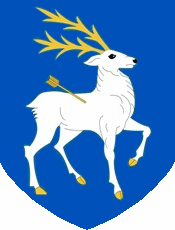
Uniform
Until 1914 the distinguishing colour of the Don Cossack Host was red: worn on the cap bands and wide trouser stripes of a dark blue uniform of the loose-fitting cut common to the Steppe Cossacks. Tall lambskin hats were worn on occasion, with red cloth tops. Shoulder-straps were the same dark blue as the caftan (coat). A whip was used instead of spurs.[23] Prior to 1908, individual cossacks from all Hosts were required to provide their own uniforms (together with horses and harness). However the size and relative affluence of the Don Cossack Host permitted the setting up of communally owned clothing factories.
A khaki field tunic was adopted in 1908, replacing the dark blue coats or white (summer) blouses previously worn for ordinary duties. However the blue riding breeches with broad red stripes long characteristic of the Don Host, continued to be worn even on active service during both World Wars.
Anthem of Don Cossacks
Всколыхнулся, взволновался православный Тихий Дон written by Fedor Anisimov in 1853.[24] (Russian)
Religion
Most Don Cossacks are Russian Orthodox, who consider themselves guardians of the faith. However, a large percentage of Don Cossacks were Starovers.[25] Even in 1903, a minimum of 150,000 from a total of the 2,500,000 parish members of the Don Eparchy were Starovers.[26] Ataman count Matvei Platov was of a Popovtsy Old Believers Family.[27] Don Cossacks were tolerant of other religions -with the exception of Jews- and accepted Buddhists, Muslims, Old Believers, and pagans into their communities.[28]
Traditions and culture

The Cossacks had a democratic society where the most important decisions were made during a Common Assembly (Казачий Круг). The assembly elected temporary authorities — atamans.
Don Cossacks were skilled horsemen and experienced warriors, due to their long conflict with the Crimean Khanate and the Ottoman Empire. They sold their military services to different powers in Eastern Europe. Together with the Polish King, they raided Moscow during the Time of Troubles (Смутное Время) and, under Russian authority, carried out raids and expeditions against Ottoman Turkey and Qajar Persia.
Isolated between Russian and Muslim territory, the Don Cossacks developed a distinct culture and language which fused Ukrainian, Russian, Kalmyk, and Tatar elements.[29]
The Don Cossacks have a tradition of choral singing and many of their songs, such as Chyorny Voron (Black Raven) and Lyubo, Bratsi, Lyubo (It's good, brothers, good) became popular throughout the rest of Russia. Many of the songs are about death in war.
Up to the 18th century marriages and divorces were held in the Common Assembly (Казачий Круг). If a Cossack wanted to marry a woman he was expected to bring her to the Common Assembly for presentation. If the Common Assembly gave approval, the marriage followed. The same procedure took place if there was a divorce. Peter I banned these practices in the Common Assembly, requiring Cossacks to marry only in church.
A Cossack marriage is a complex ritual, accompanied by songs, dances and performances. A bridegroom arrives on horseback and takes his bride to the church, followed by a marriage train. After the wedding all present would adjourn to the bridegroom's house. There, The parents would bless the couple, break a loaf of bread above their heads, and sprinkle them with wheat, nuts, sweets and hops. The bride's hair would then be unbraided according to traditional rites.
When a son was born to a Cossack family, his relatives presented him with an arrow, a bow, a cartridge, a bullet and a gun. All of these items were hung on the wall, over the boy's bed. At the age of three, the boy began to ride a horse. At the age of 7 to 8 he was allowed to ride in the street, to go fishing and hunt with grown-ups.
Horse racing was a popular pastime with Don Cossacks. Riders competed to hit a target, firing weapons from horseback. The most dexterous were able to do this standing on the horses back. It was traditional practice for Cossack families to provide a young Cossack with two horses, a uniform and weapons.
Cossack leave-taking was always festive. All departing Cossacks would gather in the church, then hang a small bag around their necks containing a pinch of their native soil before setting off singing. Having left their stanitsa, they drank a cup of vodka and said good-bye to their native land.

Don Cossack Choir Serge Jaroff
The Don Cossack Choir Serge Jaroff was a group of former officers of the Russian Imperial Army who were discovered singing in Çilingir (near Constantinopel), where they had fled after the defeat of their army in the Crimea. They made their formal concert debut in Vienna in 1923, led by their founder, conductor and composer, Serge Jaroff.
The choir became popular in America, Japan and Europe, touring the world in the 1930s, 40s and 50s, till today. The men, dressed as Cossacks, sang a cappella in a repertory of Russian sacred and secular music, army, folk and art songs. Cossack dancing was eventually added to their programme.
In popular culture
Mikhail Sholokhov's monumental work, "And Quiet Flows the Don", deals sympathetically with the Don Cossacks and depicts the destruction of their way of life as a result of World War I and the Russian Civil War.
See also
Notable Don Cossacks
- Don Cossacks noble families
- Kondraty Bulavin
- Alexei Kaledin
- Pyotr Krasnov
- Matvei Platov
- Emilian Pugachev
- Stenka Razin
 Stenka Razin, Don Cossack leader who led a major uprising
Stenka Razin, Don Cossack leader who led a major uprising - Yermak Timofeyevich
- Ivan Turchaninov — Union army brigadier general in the American Civil War.
- Aleksandr Khanzhonkov
Don Cossacks government and policy
Don Cossack books
Genocide and Don Cossacks
- Decossackization
- Repatriation of Cossacks after World War II — "betrayal of the Cossacks".
- "Victims of Yalta" — 1977 book.
- Ethnic Cleansing of Circassians
- Genocides in history
- Human rights in the Soviet Union
- Population transfer in the Soviet Union
Footnotes
- ↑ "Демоскоп Weekly - Приложение. Справочник статистических показателей.". Retrieved 23 April 2015.
- ↑ Russian History Dating Back to the Most Ancient Times by Vasily Tatishchev Vol.1., Chapter 33:7. 1739
- ↑ "В.О. Ключевский. Курс русской истории. Лекция 45". Retrieved 23 April 2015.
- ↑ See works of Evgueni Goloubinski and Vasily Vasilievsky about Relations of Gothoalans (Goths-Tetraxits) and Russian colonists in region of North-East part of Black Sea and Sea of Azov
- ↑ Keyser, C.; Bouakaze, C.; Crubézy, E.; Nikolaev, V. G.; Montagnon, D.; Reis, T.; Ludes, B. (2009). "Ancient DNA provides new insights into the history of south Siberian Kurgan people". Human Genetics. 126 (3): 395–410. doi:10.1007/s00439-009-0683-0. PMID 19449030.
- ↑ "Black hoods": the Russian ancestors of the Don Cossacks
- ↑ "Городовые казаки". Retrieved 23 April 2015.
- ↑ "Новгородские казаки - Казачий Порядник. О.Данкир". Retrieved 23 April 2015.
- ↑ "Червленый Яр и рязанские казаки Воронеж". Retrieved 23 April 2015.
- ↑ Facts about Cossack: habitation of Don River basin, as discussed in Don River (river, Russia): History and economy: - Britannica Online Encyclopedia
- ↑ , pp. 8–9
- ↑ Paul Heineman, "In Defense of an Anachronism: the Cossack Question on the Don, 1861-1914." PhD Dissertation, Georgetown University, 2000.
- ↑ "Talk Of Napoleon At St. Helena". Internet Archive. Retrieved 23 April 2015.
- ↑ Littauer, Vladimir. Russian Hussar. p. 220. ISBN 1-59048-256-5.
- ↑ Albert Seaton, page 27 "The Cossacks", SBN 85045 116 7
- ↑ "armymuseum.ru". Retrieved 23 April 2015.
- ↑ Kort, Michael (2001). The Soviet Colosus: History and Aftermath, p. 133. Armonk, New York: M.E. Sharpe. ISBN 978-0-7656-0396-8.
- ↑ Albert Seaton, pages 31-32 The Cossacks, SBN 85045 116 7
- ↑ Hughes, James and Sasse, Gwendolyn: Ethnicity and territory in the former Soviet Union: regions in conflict. Taylor & Francis, 2002, page 107. ISBN 0-7146-8210-1
- ↑
- ↑ "Russians Find Few Barriers to Joining Ukraine Battle" The New York Times June 9, 2014. - "... among eastern Ukrainian militants, Cossack symbols like sheepskin hats, or the Don Cossack symbol of a stag struck by an arrow — meaning it is better to die free than to live like a slave — are commonplace."
- ↑ "Ukraine: Common history pulls in aid from west Russia". BBC News. 23 June 2014.
- ↑ page 591 of volume 27, The Encyclopaedia Britannica, Eleventh Edition
- ↑ http://a-pesni.org/grvojna/bel/vskol1918.php Anthem of Don Cossacks in Russian Civil War.
- ↑ http://www.apocalypse.orthodoxy.ru/zenkovskij/37.htm Don Cossacks in defiance of Old Faith
- ↑ Report of Antiraskol and antiheretic mission of Don Eparchy for 1903 (Отчет о деятельности Противораскольнической и противоеретической миссии Донской епархии за 1903 г.)
- ↑ Woorgaft S.G., Ushakov I.A. Old Believing. Moscow, 1996. (Вургафт С. Г., Ушаков И. А. Старообрядчество. Лица, события, предметы и символы. Опыт энциклопедического словаря, Москва, 1996)
- ↑ Minahan, James (2000). One Europe, Many Nations: A Historical Dictionary of European National Groups. Greenwood Press. p. 216. Retrieved 9 December 2013.
- ↑ Encyclopedia of the Stateless Nations: D-K, By James Minahan. page 540
Further reading
- Peter Holquist, "'Conduct Merciless Mass Terror': Decossackization on the Don, 1919," Cahiers du Monde russe, vol. 38, no. 1/2(Jan.-June 1997), pp. 127-162. In JSTOR
External links
| Wikimedia Commons has media related to Kuban Cossacks. |
- Doncossacks.ru: The Don Cossack Museum — in Novocherkassk.
- Novocherkassk.net: Novocherkassk—the Capital of Don Cossacks
- Kuban.in.ua: History of the Don Cossacks
- Russian Army Museum: History of the Cossacks — (in English)
